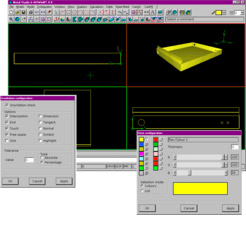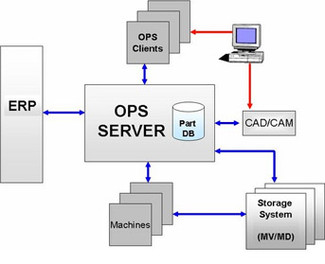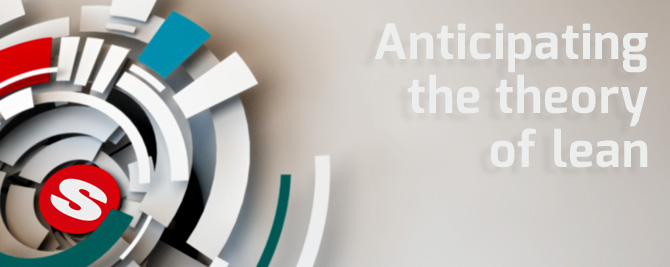Lean manufacturing - Anticipating The Theory Of Lean
Origins
Decades before James P. Womack formalized the theory he called "lean manufacturing". Salvagnini had been aggressively putting those very same principles into practice in its unremitting drive to eliminate wasted time and wasted materials throughout the entire sheet metal fabrication process.
Understanding the big picture
By maintaining its focus first on process and then on operations, Salvagnini is constantly helping its customers to reduce the length of time between receipt of an order and delivery of finished products. Recognizing that 90-95% of the cost of fabricated products is consumed by non-manufacturing operations, Salvagnini has been unwavering in its drive to eliminate time wasting practices that siphon off value. Salvagnini is achieving its goal by developing the industry's most advanced software, flexible automation, and intelligent material handling systems to complement what are already the most efficient and versatile punching, shearing, laser cutting and bending machines in the business.
Salvagnini delivers
The principles of single piece part flow, minimal setups, optimal inventory management, reduced WIP and JIT delivery are what define lean manufacturing. And whether you're looking at component building blocks or a completely Automated Job Shop, no one does it better than Salvagnini.
- DESIGN
- MANAGEMENT
- MANUFACTURING
- MAINTENANCE

Design considerations
Lean manufacturing starts with design for manufacturing, and the first challenge all industrial designers face is age-old question of how to combine the practical and aesthetic into a pleasing, yet functional form. The second challenge, fundamental to lean manufacturing, is to determine how to make the part in the quickest, most cost effective manner. The first is up to the skill and talent of the designer. For owners of Salvagnini systems, the second challenge is no challenge at all.
Unified design and production
Salvagnini's suite of support tools is called MetalStudio. This design and production software promotes lean manufacturing by giving industrial designers the power to create and test a part design in the computer, off-line, with complete confidence that what can achieved in simulation can be produced on the shop floor. Once a design is selected, MetalStudio automatically programs Salvagnini punching, laser cutting or bending machines to fulfill Salvagnini's promise that the first part is always a good part. Production is not interrupted for prototyping. Time is saved. Waste eliminated. Efficiency is achieved.
Design from a distance
One of the defining features of lean manufacturing is outsourcing, and MetalStudio is the ideal tool for companies using consultants, tier two job shops, or Salvagnini's design team for product design. Simply import the 3D CAD drawings from Pro/E, SolidWorks, Solid Edge, etc. - and let the software program the Salvagnini systems, regardless of whether the design originates from the next office or around the world.
Where Value Is Created
The principles and practices of lean manufacturing are a response to demands of increasingly more sophisticated consumers, driving companies to continuously improve every aspect of the value chain. Ultimately, all of the efforts of the many skilled and talented people it takes to bring a product to market coalesce in the manufacturing units responsible for producing the products. Managers must be prepared, flexible, quick to react, cost effective and quality conscious to survive in that kind of environment - an environment Salvagnini has been inhabiting for over 30 years.
Control & Feedback
Through its decades long emphasis on creating flexible manufacturing systems (FMS) that reduce overall process time, Salvagnini has developed the tools of lean manufacturing that managers of sheet metal fabrication shops rely upon for system control and feedback. Flexible, automatic punching, shearing, laser cutting and bending machines that respond instantly to demands for either batch production or single piece part processing. Material handling systems that managers use to control inventories and reduce work in process. Opera software that dialogues with ERP systems to initiate projects and provide real-time progress reports. MetalStudio programming that transforms drawings to finished products at the push of a button.
Salvagnini's modular sheet metal processing systems are structured so that companies can build the kind of scalable FMS that suits their needs - one component at a time - to achieve the flexibility, agility, speed, control and feedback that defines lean manufacturing management.
Gaining A Competitive Edge
The goal of lean manufacturing is to create a competitive advantage by reducing manufacturing costs through the elimination of waste in the production process. Salvagnini's historic concentration on improving the entire process of sheet metal fabrication has always employed the very same strategy, which is why Salvagnini is ideally positioned to provide direction and counsel to those companies who want to adopt the practices of lean manufacturing.
The Industry Model
ASR systems keep parts and material inventory at optimum levels, while proprietary programming eliminates queuing and delivers material where it's needed, when it's needed. Work in process is held to a minimum. All design and part programming is conducted off-line so that production can continue unabated. Individual machines and manufacturing cells are loaded and unloaded robotically and all part manipulation is automatic, creating a completely unmanned workplace. The result of Salvagnini technology is an unprecedented ability to produce an unlimited variety of products in small job lots, available for just in time delivery, without wasted time. The very definition of lean manufacturing.
The Epitome Of Lean
Because Salvagnini has always looked to the future for inspiration, all Salvagnini sub-systems are both modular and scalable. That means job shops and large fabricators alike can grow an AJS one machine, one system, at a time as needs and resources permit. It means they can cut waste one machine, one system, at a time to achieve lean manufacturing.

Added Value Through Reduced Downtime
Lean companies are always looking for ways to eliminate the machine downtime that increases overhead and steals value from finished products. Defined in lean manufacturing terms, downtime includes both idle periods while an operation is waiting for inventory or work in process to arrive and service time due to breakdowns. With a Salvagnini flexible manufacturing system, idle time is virtually eliminated by complete process automation guided by Opera-OPS (Order Processing System) software. Quality craftsmanship and proprietary software make service due to breakdowns rare and allow planned maintenance to keep downtime to a minimum.
Planning Ahead
Salvagnini's preventive maintenance program and proprietary software, Maintenance Manager, provide the ability to anticipate service needs by monitoring all machine activity. Feedback of a manufacturing unit's status is constant, including a running total of sheet metal consumption, which is a reliable predictor of tool wear. Maintenance Manager will also alert manufacturing management when preventative maintenance or unscheduled service is necessary so that technicians can be scheduled for off-peak hours.
When maintenance is required, it can be conducted by in-house personnel, guided every step of the way by program documentation, or Maintenance Manager can be customized to send data directly to Salvagnini, so a Salvagnini technician can schedule a service call on a timely basis. The result of this planned maintenance is reduced down time, which means cost savings, increased productivity and a leaner manufacturing operation.





